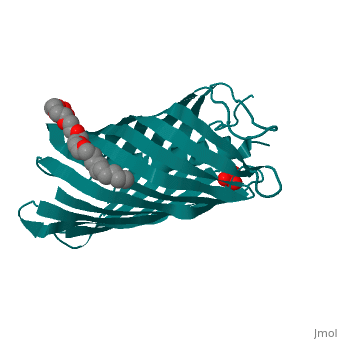1uyn: Difference between revisions
No edit summary |
No edit summary |
||
| Line 4: | Line 4: | ||
==Overview== | ==Overview== | ||
Autotransporters are virulence-related proteins of Gram-negative bacteria | Autotransporters are virulence-related proteins of Gram-negative bacteria that are secreted via an outer-membrane-based C-terminal extension, the translocator domain. This domain supposedly is sufficient for the transport of the N-terminal passenger domain across the outer membrane. We present here the crystal structure of the in vitro-folded translocator domain of the autotransporter NalP from Neisseria meningitidis, which reveals a 12-stranded beta-barrel with a hydrophilic pore of 10 x 12.5 A that is filled by an N-terminal alpha-helix. The domain has pore activity in vivo and in vitro. Our data are consistent with the model of passenger-domain transport through the hydrophilic channel within the beta-barrel, and inconsistent with a model for transport through a central channel formed by an oligomer of translocator domains. However, the dimensions of the pore imply translocation of the secreted domain in an unfolded form. An alternative model, possibly covering the transport of folded domains, is that passenger-domain transport involves the Omp85 complex, the machinery required for membrane insertion of outer-membrane proteins, on which autotransporters are dependent. | ||
==About this Structure== | ==About this Structure== | ||
| Line 14: | Line 14: | ||
[[Category: Single protein]] | [[Category: Single protein]] | ||
[[Category: Feijen, M.]] | [[Category: Feijen, M.]] | ||
[[Category: Gelder, P | [[Category: Gelder, P Van.]] | ||
[[Category: Gros, P.]] | [[Category: Gros, P.]] | ||
[[Category: Oomen, C | [[Category: Oomen, C J.]] | ||
[[Category: Tommassen, J.]] | [[Category: Tommassen, J.]] | ||
[[Category: Ulsen, P | [[Category: Ulsen, P Van.]] | ||
[[Category: CXE]] | [[Category: CXE]] | ||
[[Category: SO4]] | [[Category: SO4]] | ||
| Line 28: | Line 28: | ||
[[Category: translocator domain]] | [[Category: translocator domain]] | ||
''Page seeded by [http://oca.weizmann.ac.il/oca OCA ] on | ''Page seeded by [http://oca.weizmann.ac.il/oca OCA ] on Thu Feb 21 15:29:48 2008'' | ||
Revision as of 16:29, 21 February 2008
|
TRANSLOCATOR DOMAIN OF AUTOTRANSPORTER NALP FROM NEISSERIA MENINGITIDIS
OverviewOverview
Autotransporters are virulence-related proteins of Gram-negative bacteria that are secreted via an outer-membrane-based C-terminal extension, the translocator domain. This domain supposedly is sufficient for the transport of the N-terminal passenger domain across the outer membrane. We present here the crystal structure of the in vitro-folded translocator domain of the autotransporter NalP from Neisseria meningitidis, which reveals a 12-stranded beta-barrel with a hydrophilic pore of 10 x 12.5 A that is filled by an N-terminal alpha-helix. The domain has pore activity in vivo and in vitro. Our data are consistent with the model of passenger-domain transport through the hydrophilic channel within the beta-barrel, and inconsistent with a model for transport through a central channel formed by an oligomer of translocator domains. However, the dimensions of the pore imply translocation of the secreted domain in an unfolded form. An alternative model, possibly covering the transport of folded domains, is that passenger-domain transport involves the Omp85 complex, the machinery required for membrane insertion of outer-membrane proteins, on which autotransporters are dependent.
About this StructureAbout this Structure
1UYN is a Single protein structure of sequence from Neisseria meningitidis with and as ligands. Known structural/functional Site: . Full crystallographic information is available from OCA.
ReferenceReference
Structure of the translocator domain of a bacterial autotransporter., Oomen CJ, van Ulsen P, van Gelder P, Feijen M, Tommassen J, Gros P, EMBO J. 2004 Mar 24;23(6):1257-66. Epub 2004 Mar 11. PMID:15014442
Page seeded by OCA on Thu Feb 21 15:29:48 2008
